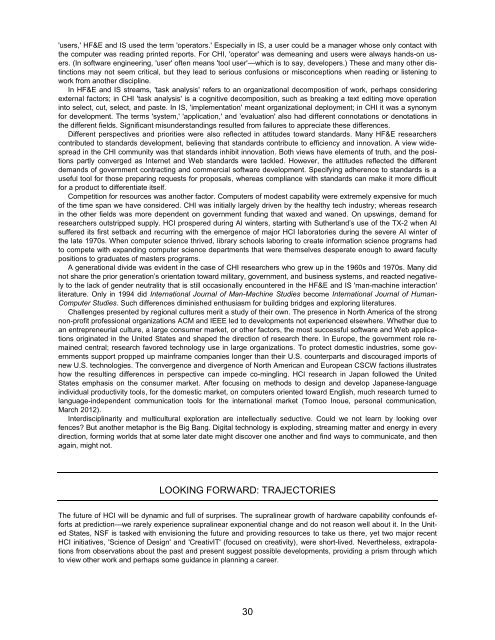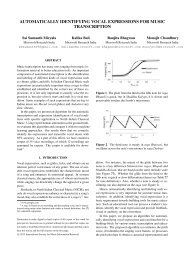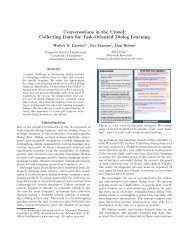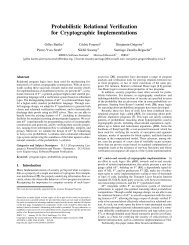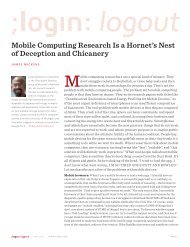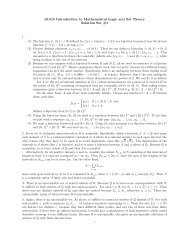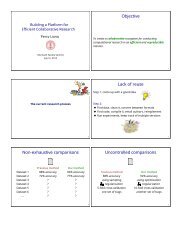A Moving Target—The Evolution of Human-Computer Interaction
A Moving Target—The Evolution of Human-Computer Interaction
A Moving Target—The Evolution of Human-Computer Interaction
Create successful ePaper yourself
Turn your PDF publications into a flip-book with our unique Google optimized e-Paper software.
'users,' HF&E and IS used the term 'operators.' Especially in IS, a user could be a manager whose only contact with<br />
the computer was reading printed reports. For CHI, 'operator' was demeaning and users were always hands-on users.<br />
(In s<strong>of</strong>tware engineering, 'user' <strong>of</strong>ten means 'tool user'—which is to say, developers.) These and many other distinctions<br />
may not seem critical, but they lead to serious confusions or misconceptions when reading or listening to<br />
work from another discipline.<br />
In HF&E and IS streams, 'task analysis' refers to an organizational decomposition <strong>of</strong> work, perhaps considering<br />
external factors; in CHI 'task analysis' is a cognitive decomposition, such as breaking a text editing move operation<br />
into select, cut, select, and paste. In IS, 'implementation' meant organizational deployment; in CHI it was a synonym<br />
for development. The terms 'system,' 'application,' and 'evaluation' also had different connotations or denotations in<br />
the different fields. Significant misunderstandings resulted from failures to appreciate these differences.<br />
Different perspectives and priorities were also reflected in attitudes toward standards. Many HF&E researchers<br />
contributed to standards development, believing that standards contribute to efficiency and innovation. A view widespread<br />
in the CHI community was that standards inhibit innovation. Both views have elements <strong>of</strong> truth, and the positions<br />
partly converged as Internet and Web standards were tackled. However, the attitudes reflected the different<br />
demands <strong>of</strong> government contracting and commercial s<strong>of</strong>tware development. Specifying adherence to standards is a<br />
useful tool for those preparing requests for proposals, whereas compliance with standards can make it more difficult<br />
for a product to differentiate itself.<br />
Competition for resources was another factor. <strong>Computer</strong>s <strong>of</strong> modest capability were extremely expensive for much<br />
<strong>of</strong> the time span we have considered. CHI was initially largely driven by the healthy tech industry; whereas research<br />
in the other fields was more dependent on government funding that waxed and waned. On upswings, demand for<br />
researchers outstripped supply. HCI prospered during AI winters, starting with Sutherland’s use <strong>of</strong> the TX-2 when AI<br />
suffered its first setback and recurring with the emergence <strong>of</strong> major HCI laboratories during the severe AI winter <strong>of</strong><br />
the late 1970s. When computer science thrived, library schools laboring to create information science programs had<br />
to compete with expanding computer science departments that were themselves desperate enough to award faculty<br />
positions to graduates <strong>of</strong> masters programs.<br />
A generational divide was evident in the case <strong>of</strong> CHI researchers who grew up in the 1960s and 1970s. Many did<br />
not share the prior generation’s orientation toward military, government, and business systems, and reacted negatively<br />
to the lack <strong>of</strong> gender neutrality that is still occasionally encountered in the HF&E and IS 'man-machine interaction'<br />
literature. Only in 1994 did International Journal <strong>of</strong> Man-Machine Studies become International Journal <strong>of</strong> <strong>Human</strong>-<br />
<strong>Computer</strong> Studies. Such differences diminished enthusiasm for building bridges and exploring literatures.<br />
Challenges presented by regional cultures merit a study <strong>of</strong> their own. The presence in North America <strong>of</strong> the strong<br />
non-pr<strong>of</strong>it pr<strong>of</strong>essional organizations ACM and IEEE led to developments not experienced elsewhere. Whether due to<br />
an entrepreneurial culture, a large consumer market, or other factors, the most successful s<strong>of</strong>tware and Web applications<br />
originated in the United States and shaped the direction <strong>of</strong> research there. In Europe, the government role remained<br />
central; research favored technology use in large organizations. To protect domestic industries, some governments<br />
support propped up mainframe companies longer than their U.S. counterparts and discouraged imports <strong>of</strong><br />
new U.S. technologies. The convergence and divergence <strong>of</strong> North American and European CSCW factions illustrates<br />
how the resulting differences in perspective can impede co-mingling. HCI research in Japan followed the United<br />
States emphasis on the consumer market. After focusing on methods to design and develop Japanese-language<br />
individual productivity tools, for the domestic market, on computers oriented toward English, much research turned to<br />
language-independent communication tools for the international market (Tomoo Inoue, personal communication,<br />
March 2012).<br />
Interdisciplinarity and multicultural exploration are intellectually seductive. Could we not learn by looking over<br />
fences? But another metaphor is the Big Bang. Digital technology is exploding, streaming matter and energy in every<br />
direction, forming worlds that at some later date might discover one another and find ways to communicate, and then<br />
again, might not.<br />
LOOKING FORWARD: TRAJECTORIES<br />
The future <strong>of</strong> HCI will be dynamic and full <strong>of</strong> surprises. The supralinear growth <strong>of</strong> hardware capability confounds efforts<br />
at prediction—we rarely experience supralinear exponential change and do not reason well about it. In the United<br />
States, NSF is tasked with envisioning the future and providing resources to take us there, yet two major recent<br />
HCI initiatives, 'Science <strong>of</strong> Design' and 'CreativIT' (focused on creativity), were short-lived. Nevertheless, extrapolations<br />
from observations about the past and present suggest possible developments, providing a prism through which<br />
to view other work and perhaps some guidance in planning a career.<br />
30


